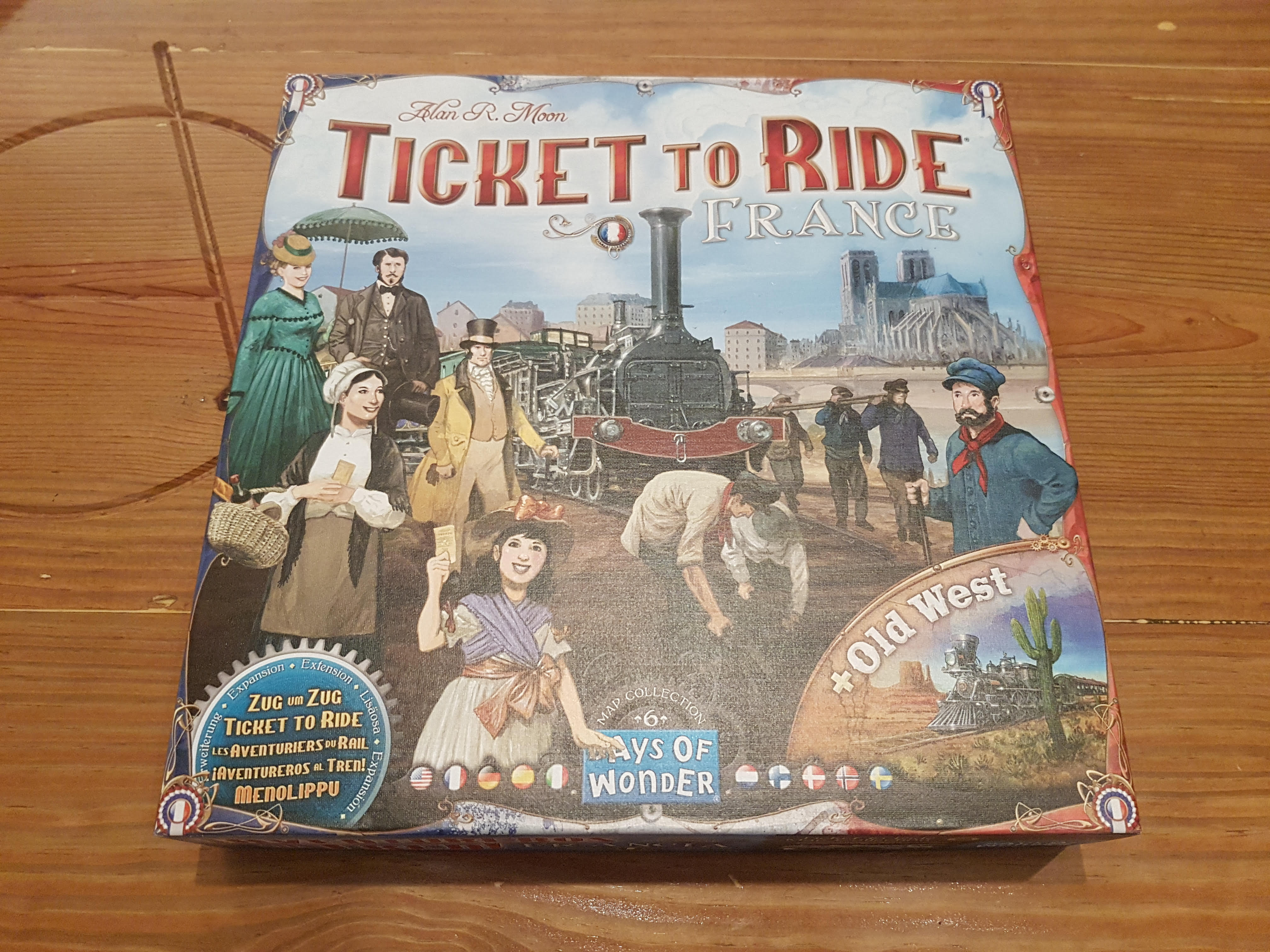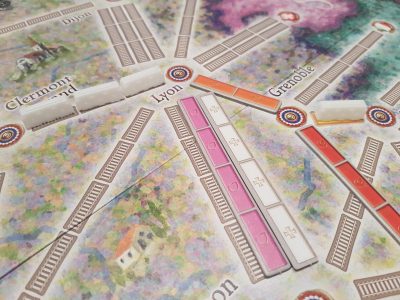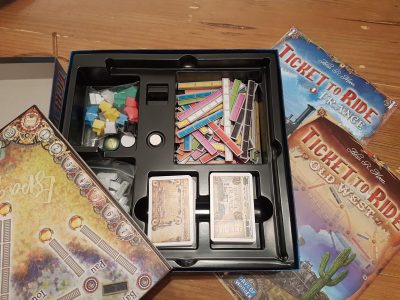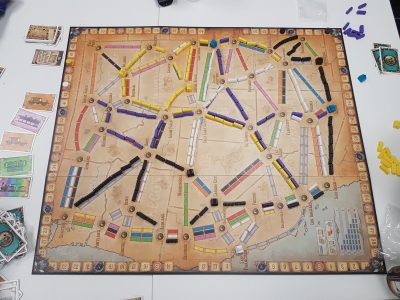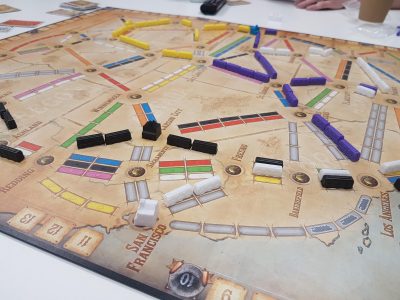Ticket to Ride Map Collection: Volume 6 – France & Old West is the latest expansion for the famous train based, set collection and route building board games. Designed by Alan R. Moon and published by Days of Wonder, as the name suggests, this expansion comes with two maps to play on – utilizing a double-sided board. One side sees 2 – 5 players networking across France, while the other enables 2 – 6 players to grow slowly across the Old West. An average game takes just over an hour, creeping up to an hour and a half with the highest player counts. However, does this expansion add to the series or is it just another map? Let’s find out!
For those new to the franchise as an expansion this game cannot be played without also owning Ticket to Ride (US), Ticket to Ride Europe or Ticket to Ride Germany, as only a set of white trains is included in the box. When the game gets going, on the table is a large map of France or on the reverse side Old West America. Normally, though it is still the case with Old West, snaking across this map are colourful train routes. Splitting these routes up are stations, named after and roughly located where the real-life cities should be.
On a turn, players will either draw Train cards, claim a route or draw new destination tickets. Train tickets come in the colours that routes on the board are made of. Normally this would end your turn, though this action also triggers track placement in the France ruleset. When you draw train cards, no matter where from, you also must place a Track piece onto an empty track bed. This then enables the route to be claimed via Train Cards.
To claim a route a set of a coloured Train cards matching the colour of that route is required, the amount set by the length of the route. When a route is claimed the track piece is removed when the trains are added to the board, making it once again available to be placed elsewhere. As with all Ticket to Ride games the aim is to complete destination cards which have two cities which you must link together via connecting routes. Players score points for completed destination tickets but lose points for those left incomplete.
There are some additional stipulations to building the track pieces. The France board has been designed so that in specific places two or more routes, in Track Bed form, cross. When a track piece is played on such a space the others it crosses become unavailable. As with the base games you cannot in 2/3 player games claim multiple tracks of the double or triple routes and this extends onto the building of the track pieces, so once the colour is chosen that double route is locked down. This helps the same board feel just as tight when there isn’t the full player count.
The France side, despite the size, can be one of the most block friendly, take-that, style maps if players want it to be. See a player slowly collecting a handful of a specific colour then use up track pieces of that colour randomly across the board. This can make life hard for another player without even placing trains to stop them. Being a big board, players can still attempt to keep to themselves, doing their own thing. Yet, like Ticket to Ride Nordic Countries the potential of accidental take-that actions is higher than normal.
For fans of the series the colossal size of the board will be very welcoming. On top of this, the way players give away the colours they are going for and routes, as they place track pieces, adds in new ways get an insight into opponents’ destination tickets. This same extension to the gameplay and board can be somewhat off putting for new players as they get overly daunted by the experience. For such a minor increase in weight (difficulty) the France mechanic certainly manages to intimidate those new to the hobby more than most Ticket to Ride expansions, though not anywhere near as much as the United Kingdom board. It is still the same game at heart and once gamers have played a game or two of any of the base games they’ll be more than ready to attempt France.
The Old West side of the board introduces a different way that players must build out their railway empires. As a result, this may confuse new players in the long run, getting to grips with non-standard rules. However, for veterans of the series it is an interesting new way to play. In Old West players have a starting city and must build their network out from this city. Once a new location is linked to their railroads can now fan out from this new location and so on across the map. This shakes up the ability to grab routes randomly around the board, therefore stopping the ability of long range route sniping.
The possibility to screw over an opponent is not entirely gone, as routes can still be claimed if you snake across the board enough. On top of this cities can see players stealing points from others. To build a city a player must spend an additional two cards of matching colour, though these don’t need to be the same colour as the claimed route. That player can then choose to put a city at either end of the route, as long as it is a free location. In the future whenever another player builds a route that connects to this city, whomever owns the city gets the points for the route. If a route has a city at both ends both players get the points.
Getting these cities in specific locations, such as Salt Lake City near the middle of the board with long routes protruding from it, can see massive returns for the owner. This goes above and beyond blocking with trains point-wise, though it does not stop opponents from claiming the route, thus enabling them to still finish a destination ticket. Despite not physically stopping the player they will have to make the decision if it is worth gifting points away to finish a route: which is a different mentality from what players normally use in the Ticket to Ride franchise.
The city components are very similar in quality to the stations from Ticket to Ride Europe. They are an obvious shape that pops from the board itself and the plastic train carriages that cover the routes. They do have some vague details but these components are more about their obvious silhouette rather than nice details buildings. Despite being usable as an expansion to Ticket to Ride Germany do note than no purple cities are included, so using the purple trains from the Germany box results in that player having to use different coloured cities. It’s an odd decision not to include these as it seems that purple is a commonly chosen colour when available, and Ticket to Ride Germany was the last base like box to be released.
When playing on the Old West side of the board there is a gameplay variant which includes Alvin the Alien. Alvin starts in Roswell and scores a player 10 points when a route to Roswell is built. At this point Alvin is moved to one of that players cities and the other players can attempt to link to it to score 10 points and so on. Alvin is an almost unnecessary blast from the past, it’ll be good for those whom have the figure to once again let it see the light of day. Otherwise, it feels out of place and therefore I leave the cardboard Alvin token in the box.
The map collection may be referred to as Ticket to Ride France but it is hard to see which side of the board truly shines most. I wouldn’t throw a new player into either without considering their gaming experience, as the additional rules would slow down getting the game to the table and potentially taint their initial enjoyment of the franchise. For those of us with Ticket to Ride games under our belts, these maps shake the gameplay up whilst keeping the core feeling of claiming routes the same. The way the France side has a feeling of building up the tracks and routes is like a new layer of strategy and the way players must construct a flowing train network just works in the Old West. The size of the board means the game requires a little extra space on the table: however, for the freshness the variants bring to the table, the space the box needs on the shelf has been certainly earnt.
[Editor’s Note: Ticket to Ride France was provided to us for the review by Days of Wonder.]

